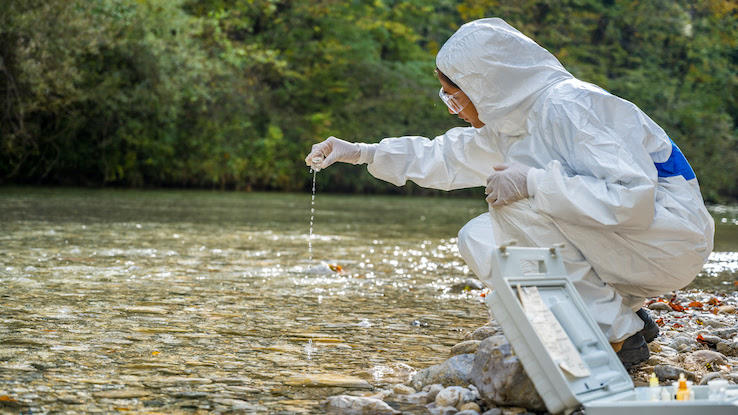
In the United States, more than 7 million people every year are impacted by a waterborne illness. This means that, although the United States has relatively safe drinking water, germs are still often able to spread from person to person and cause disease through contaminated water.
Usually, waterborne illness occurs after you drink water that’s contaminated with a disease-causing germ. This type of illness tends to involve gastrointestinal symptoms, like diarrhea or vomiting. However, it’s also possible to contract an upper respiratory or skin infection after you’ve been exposed to waterborne germs but haven’t ingested them. Recreational activities like swimming and boating provide opportunities for germs to enter your body and lead to symptoms.
Waterborne illness symptoms can range from mild to severe, and some can even be life-threatening. Read on to find out more about particular pathogens, treatment options and ways to keep yourself safe from contaminated water sources.
Types of Waterborne Illness

Various germs and other contaminants have the potential to cause disease when they enter the human body. These are the typical types of contaminants that cause waterborne diseases:
- Bacteria (such as campylobacteriosis, cholera, legionellosis, salmonella and vibrio)
- Viruses (such as viral gastroenteritis, hepatitis A and adenovirus)
- Protozoa, parasites (such as amebiasis, cryptosporidiosis giardia)
- Algae blooms and resulting biotoxins
A Note About Giardia
Giardiasis is an infection caused by a microscopic parasite called Giardia lamblia. It’s one of the most common gastrointestinal diseases contracted from contaminated water in every part of the world. Typically, the germ spreads when soil, food or feces that contain microscopic cysts from an infected source enter a body of water. Giardia infection occurs when people drink the contaminated water and the parasite enters their digestive tracts. Common symptoms include:
- Fatigue
- Weight loss
- Dehydration
- Increased gas
- Nausea or vomiting
- Bloating or stomach cramping
- Soft, greasy stools or watery diarrhea
Giardia symptoms can last several weeks and sometimes recur for an even longer period of time. It’s important to talk with a healthcare provider if you notice these symptoms begin. This can help you avoid long-term complications. Sometimes, medications can help alleviate your symptoms, too.
Waterborne Illness Prevention Tips

To prevent giardia and other waterborne illnesses, use these tips during any exposure to water:
- Drink bottled water: Especially when you’re traveling or you’re not sure if water is safe to drink, stick to bottled water. Within the U.S., the Food and Drug Administration (FDA) regulates the filtration and safety procedures involved in manufacturing bottled water. Look for labels that identify “current good manufacturing practice” (CGMP).
- Wash your hands: After any contact with water that may be contaminated, wash with soap and water for at least 20 seconds. Keep in mind that most hand sanitizers aren’t effective against pathogens like giardia; soap and water are most effective.
- Purify untreated water: Any water you access from wells, lakes, rivers or natural springs that hasn’t been treated for public use should be boiled to at least 158 degrees Fahrenheit for 10 minutes or more in order to kill potential pathogens.
- Avoid ingestion: When you’re swimming in natural bodies of water, remember to keep your mouth closed as much as possible. This helps you avoid taking in water that may be contaminated. Shower off after swimming whenever possible.
Local public health departments and environmental researchers monitor outbreaks of waterborne illness. They also track the severity of the diseases to maintain standards of water treatment. These efforts lower the public’s risk of contracting waterborne illnesses.
However, it’s important to be aware of the risks and to speak with your healthcare provider right away if you experience symptoms after coming into contact with an unfamiliar water source. People who are immunocompromised are particularly at risk of getting severely ill after exposure to waterborne germs.
Resource Links:
“Recreational Waterborne Illnesses: Recognition, Treatment, and Prevention,” American Family Physician
“Waterborne Disease in the United States | Water-related Topics | Healthy Water,” Centers for Disease Control and Prevention
“Estimate of incidence and cost of recreational waterborne illness on United States surface waters,” Environmental Health
“Waterborne Diseases,” Arizona Department of Health Services
https://www.cdc.gov/parasites/giardia/index
“Giardia infection (giardiasis) – Symptoms and causes,” Mayo Clinic
“Methods to Measure Waterborne Contaminants Research to Minimize Health Risks,” Environmental Protection Agency
“Bottled Water Everywhere: Keeping it Safe,” U.S. Food and Drug Administration
“Protozoan Parasites in Drinking Water: A System Approach for Improved Water, Sanitation and Hygiene in Developing Countries,” U.S. National Library of Medicine, National Institutes of Health
“General Information | Harmful Algal Blooms,” Centers for Disease Control and Prevention





